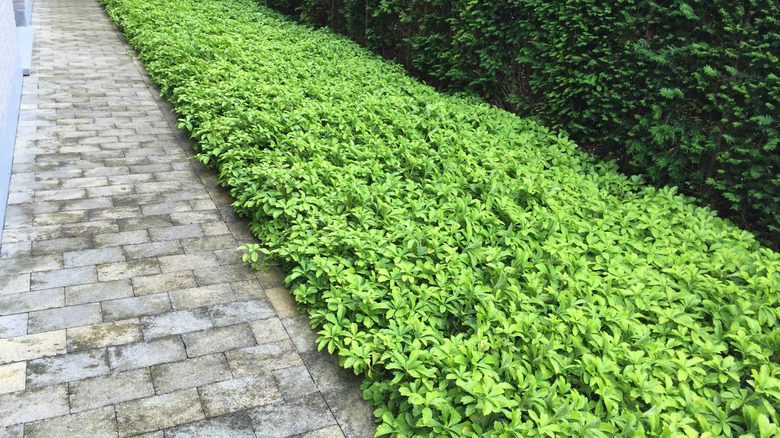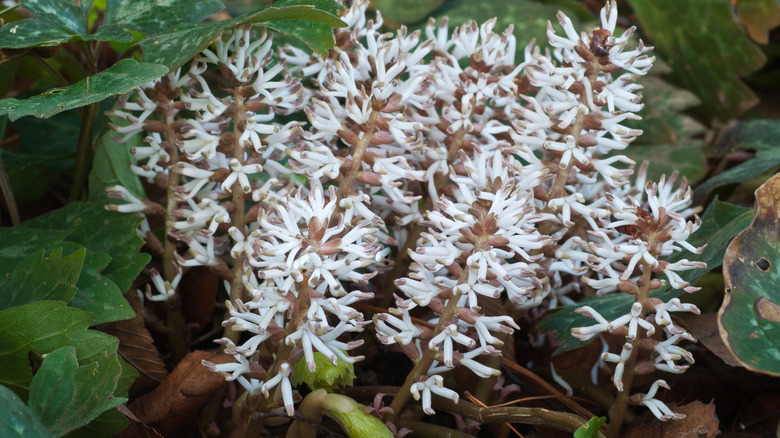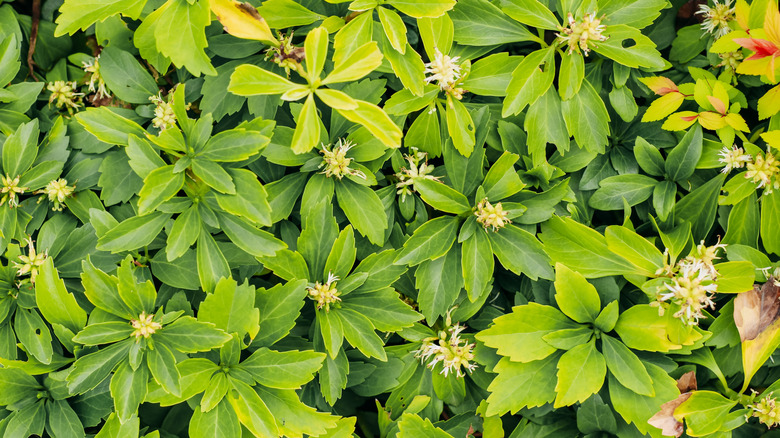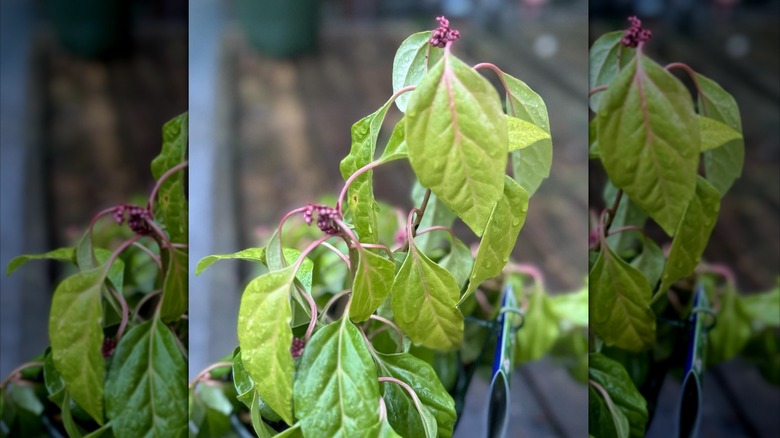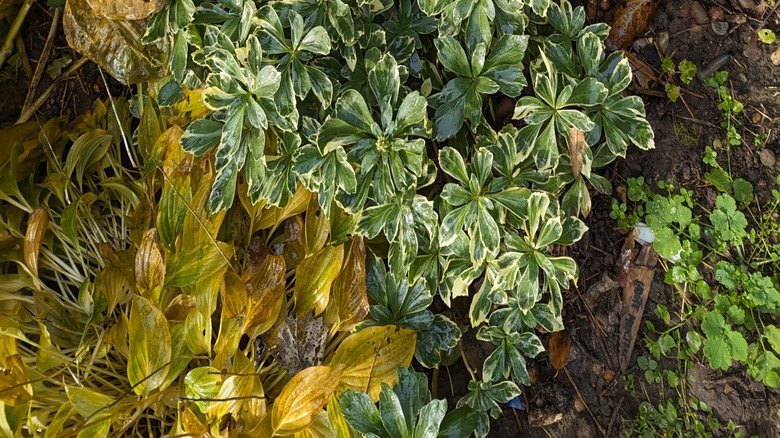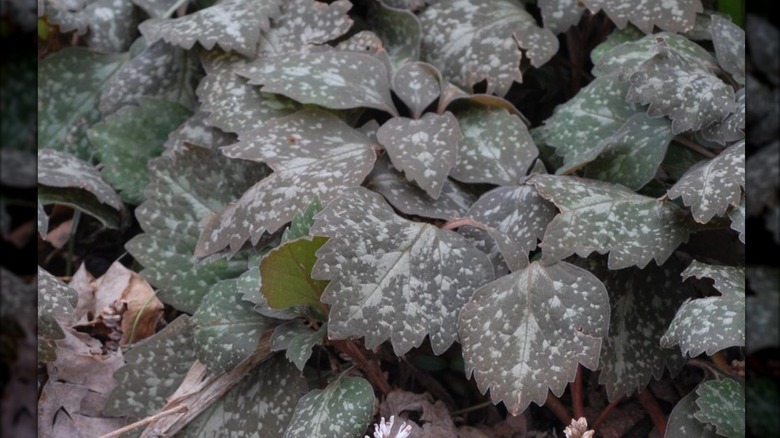Types Of Pachysandra Ground Covers You Should (And Shouldn't) Plant
The struggle to fill out your yard's shadiest expanses is real — most turfgrasses won't survive, but weeds will. While there is no shortage of ground covers that are perfect for shady areas, many recommendations default to Pachysandra. Or, to be exact, to Japanese spurge (Pachysandra terminalis) — a low-growing ground cover all too common in the northern U.S. states. It's so well-liked in the horticultural trade that it has an array of cultivars, such as 'Cutleaf,' 'Green Carpet,' 'Green Sheen,' and 'Silver Edge,' expressing myriad ornamental variations. Unfortunately, Japanese spurge turns aggressive under optimal conditions, and this quality restricts its usage in some environments.
However, Pachysandra also has a well-behaved variety: Allegheny spurge, or mountain Pachysandra (Pachysandra procumbens), which shares its Japanese counterpart's aesthetics. Mercifully, it isn't as intrusive and is popular with pollinators. It has numerous cultivars, such as 'Silver Streak', 'Pixie,' and 'Forest Green.' Another type making the nursery rounds is 'Windcliff Fragrant.' It's a cultivar of Pachysandra axillaris, an East Asian Pachysandra variety, and a repeat bloomer. With that said, we've lined up several types of Pachysandra ground covers that deserve a place in your yard — and a few that don't.
Plant: Allegheny spurge in native gardens
Tracing its origin to the Allegheny mountains — hence the name — the Allegheny spurge is the drought-resistant native spurge you should be planting for ground cover. It's earmarked by grayish-green foliage that progressively gets marbled by silver blotches as the growth season advances. By fall, the foliage turns brownish bronze, assuming lovely tinges of pink and violet. Although it's winter hardy in USDA zones 5 through 9, it doesn't remain evergreen throughout its range, save for the warmest climates and areas unexposed to north winds. This means that in lower ranges (zones 5 and 6), it sheds its leaves during winter. However, this only adds to its charm as the bare branches become engulfed in aromatic, white bloom spikes come spring, attracting bees and other beneficial insects. Even in zones 7 and above, it typically remains semi-evergreen, with the leaves looking drab when the winter is halfway through.
Native plant aficionados in the southeast U.S. region — in and around Florida, Indiana, Kentucky, Louisiana, Tennessee, and North Carolina — might appreciate Allegheny spurge for its shade tolerance. Since it withstands dappled sunlight, it grows exceedingly well underneath tall shrubs and trees. It's also appropriate in part-to-fully shaded foundation beds or for flanking walkways. Better yet, it can be mass-planted in woodland lots and allowed to naturalize. In contrast to Japanese spurge's lateral growth, Allegheny spurge sprawls 2 feet wide radially, allowing it to team up with other ground cover plants that love shade.
Avoid: Japanese spurge as it's an aggressive grower
Don't make the mistake of planting Japanese spurge, as this popular ground cover could destroy your garden — for the very reasons that help it get established. Japanese spurge is an easy-to-grow ground cover to smother weeds in your yard and garden, since it spreads by rhizomes (underground stems), establishing a thick, uniform mat. Unfortunately, it doesn't stop at weeds, suppressing abutting desirables as well and forcing monoculture plantations on property owners.
Moreover, Japanese spurge tends to ignore the memo about "boundaries," overshooting them regularly and escaping into natural areas. For this reason, it's considered invasive in Arlington, Virginia, and a weed nationwide. Worse, such blatant displacement of native vegetation deprives pollinators and wildlife of valuable resources. It's also tremendously difficult to fully purge Japanese spurge's volunteers without resorting to chemical treatments. Additionally, compared to Allegheny spurge, Japanese Pachysandra is more susceptible to fungal diseases that may cause its early demise, such as leaf and stem blight. Euonymus scales and spider mites also frequently pose problems for this Pachysandra variety.
Plant: Pachysandra axillaris 'Windcliff Fragrant' in dappled light or full shade
One cultivar worth considering is the Pachysandra axillaris 'Windcliff Fragrant', which was introduced in the U.S. by plant explorer Daniel J. Hinkley. Since this plant is a cultivar of P. axillaris, it tracks its lineage to Sichuan, China. In line with its Pachysandra peers, its glossy, evergreen leaves grow in a thick mat close to the ground. Its ability to put out a second flush helps it stand apart. In addition to blooming the characteristic bottlebrush white flowers in spring, this cultivar repeats its performance in the autumn, ensuring multi-season interest. Besides, 'Windcliff Fragrant' has a neat, compact habit, typically terminating at 6 inches at maturity. And since it's a slow grower, there is minimal risk of this Pachysandra taking over the garden.
Barring full sun, the 'Windcliff Fragrant' cultivar can thrive in all other shaded conditions, from dappled light to deep shade. It prefers standing in slightly acidic, moist soils (not waterlogged) in zones 6 through 9. Those with immense deer and bunny pressure can safely grow 'Windcliff Fragrant.' Set it around 2 feet apart for quick coverage.
Avoid: Japanese spurge 'Variegata' as a ground cover
Since growing Japanese spurge can be quite laborious because of its intensive spreading, some gardeners gravitate toward its extremely slow-growing cultivars, like 'Variegata' (Pachysandra terminalis 'Variegata'). Also sold as 'Silver Edge,' 'Variegata' remains well-behaved, keeping its colonizing tendencies in check — except in moist soils. To boot, it boasts 2- to 4-inch-long silverish-green leaves, which are often marked by milky white bands or splotches along their lengths. These features help the cultivar differentiate itself from its parent plant.
Unfortunately, 'Variegata's' growth rate is so abysmal that it's no longer a solid option for ground cover, despite the marketing speak. Sure, it still sends out rhizomes, yet the carpet doesn't dense out sufficiently to warrant good coverage. That said, if you insist, spacing it 6 inches apart may yield some results. That's why 'Variegata' is best used as a specimen plant or in borders. Moreover, vis-à-vis Japanese spurge and its other cultivars, 'Variegata' displays the most susceptibility to boxwood blight disease. It's a disease that results in complete plant defoliation and near-immediate demise and is common in warm, shaded locations.
Plant: 'Silver Streak' Allegheny Pachysandra for its silvery winter interest
In case you're still hung up on the white-mottled evergreen foliage of 'Variegata,' try Mt. Cuba Center's 2009 introduction: Pachysandra procumbens 'Silver Streak' instead. This native ground cover sprouts deep green leaves during spring, and they get riddled with silver spots by fall's arrival. Moreover, their silvery streaking persists through the winter, looking quite attractive against the otherwise dreary landscape. As is common with the Pachysandra genus, 'Silver Streak' also produces aromatic, creamy white flowers until mid-spring.
'Silver Streak' is best grown in zones 5 through 9, where its foliage retains its evergreen character instead of turning into a lackluster mass of browning, withered leaves. Keep it away from full sun, and prioritize locations with filtered, partial, or even deep shade. 'Silver Streak' is unfussy about soil conditions and pH levels, alluding to its wide adaptability. The best part, though? It's highly drought tolerant after establishment. Deer would skip its foliage to browse tasty meals elsewhere. Team it with woodland Phlox (Phlox divaricata) as a low-growing, pollinator-friendly companion or oakleaf Hydrangea (Hydrangea quercifolia) for winter interest in native gardens.
